After the first eleven matches of the season, the EFL Championship’s league table is starting to shape up. The promotion contenders have secured themselves respectable positions heading into October’s international break, along with some surprising names. With the distance between West Bromwich Albion at the top and tenth-placed Charlton Athletic being only four points, this could be a sign for an exciting season coming up.
Among the current top ten, there are names that were once thrived in the Premier League and hoping to find their glory days. There are also clubs who have been consistent performers of the Championship and one of them are Preston North End. The Lilywhites are currently sitting third on the league table, with only one point separating them from leaders West Brom and Nottingham Forest.
They have showcased an attractive style of play that relies on quick turnovers, creating counter-attacks and high pressing. Being the league’s top-scorer with 23 goals and fourth-best in terms of goal conceded with 12 goals, Preston look destined to become a contender for an automatic promotion spot. This tactical analysis scout report will provide an analysis of the secrets that contribute to Preston’s amazing start. Meanwhile, using statistics and footage, we will look at the noticeable tactical points and individuals in their tactics.
Formation
When Alex Neil was appointed as Preston’s head coach back in July 2017, he immediately employed the style of play that he felt suitable for the side. The former Norwich manager opted to go with a 4-2-3-1 formation and kept it that way over the last three seasons. Furthermore, he has the tendency of rotating his starting eleven to give the players that he has more first-team football.
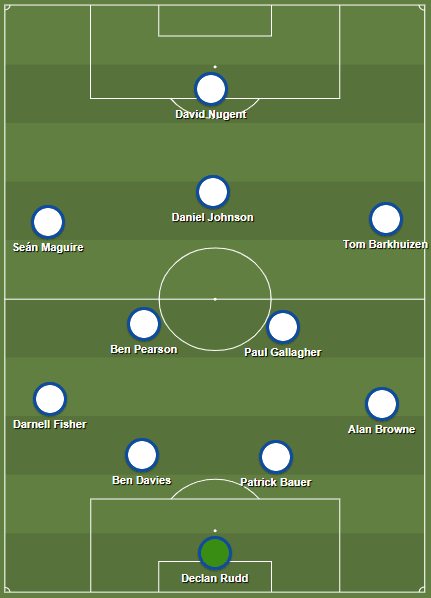
This season is not an exception either, as shown in Preston’s lineup when they welcomed Barnsley above. He tends to have versatile players among the squad, such as Darnell Fisher and Alan Browne on this occasion. The former Rotherham full-back can play on both flanks as he was chosen to fill in Joe Rafferty’s left wing. Meanwhile, Tom Barkhuizen was moved back into a right-winger from his striker spot. David Nugent filled in his place while Josh Harrop dropped to the bench.
Attacking style of play
Although not being the top leading team in the Championship, Preston stand out thanks to their goal-scoring record. With a high-tempo style of play that Neil has employed, this makes Preston one of the most prolific teams according to the numbers. On average, they registered 10.2 shots per match, a very low number compared to the league’s average. It even makes them the fourth-lowest team on the table, with only Wigan (10), Charlton (9.1) and Huddersfield (8.8) having lower shots per game than them.
Looking at how they create their attacks, it is understandable to see why they have such a low number of shots. They tend not to rely too much on playing out from the back and would rather move the ball quickly into the final third. But against teams who usually apply pressure high up the pitch, Preston are happy to take on a conservative approach which allows them to find pockets of space to progress the ball into.
Nonetheless, the main principle in their ball progression is to maintain at least one passing triangle among the players. Whenever the ball carrier holds the ball, there will be two players approaching him to offer passing options. This prevents them from making too many risky passes and lose possession to the opponent.
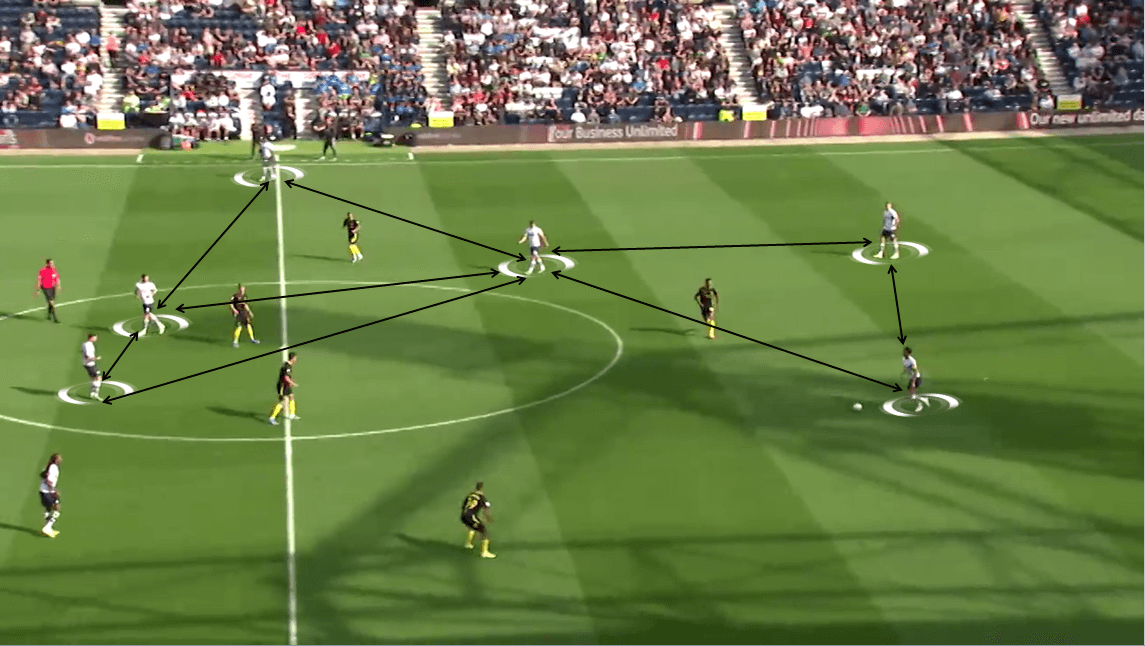
The shot above demonstrates one of Preston’s build-up situations which took place in the match against Brentford. Inside their own half, there would only be Patrick Bauer and Ben Davies, who take on the responsibility of carrying the ball forward. Both full-backs are encouraged to position themselves either on the halfway line or even join the attackers up front. They will stretch Preston’s attacking shape wider and force the opposition to do the same, which creates gaps centrally for their teammates to move in.
Meanwhile, one of the central midfielders will drop deep from his position and acts as a link between two centre-backs and the midfielders. The two players who play in that position in this match were Ben Pearson and Paul Gallagher, and they are able to flexibly swap the responsibilities with each other. As one moves close to Davies and Bauer to form a passing triangle, the other will join the attacking midfielders to create a midfield four. While this changes Preston’s formation into a 4-1-4-1, this will give them the numerical superiority when they start to progress the ball into the final third.
On several occasions, the centre-backs won’t be the player to carry the ball into the opposition’s half, but the central midfielder will. While he starts to enter the half, the attacking players will look for space where they can receive the pass and make runs into it. At times, similar to the shot below, the ball carrier could have more than one option to pass the ball as the attacking players capitalise the space that the opposition left behind.
But to make sure that they can still control possession in case those gaps are being closed down, there will be a safe option to pass for the ball carrier. Usually, the attacking midfielder is the player to take on that responsibility, which he stays near to the ball carrier and is completely free from his markers. In the situation below against Middlesbrough, the Jamaican midfielder Daniel Johnson was the player who constantly offers a passing option for the ball carrier. With his dribbling ability and the vision that helps him pick out a teammate, he fulfils the requirement of a playmaker, as we will analyse his influence on the team more thoroughly later in the article.
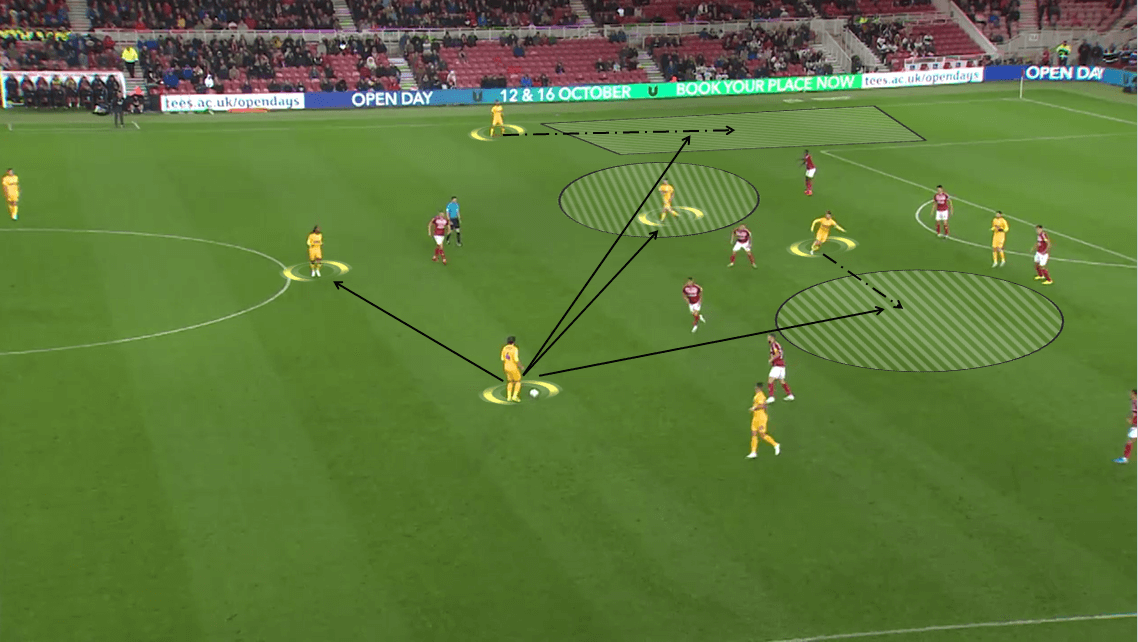
But there are situations where it wasn’t possible to create passing triangles, similar to the shot below against Barnsley. With four players swarming into the area around Pearson, the former Manchester United midfielder couldn’t keep the ball away from the pressure. The visitors managed to block every possible short-range passing option that he had around him, including a backpass towards Bauer.
Eventually, he opted to make a pass up front and hoped to find Barkhuizen, which was easily intercepted by Aapo Halme. This raised a concern about how they would deal with this problem when playing against teams who employ aggressive pressing when out of possession. It would be possible for the opposition to force Preston to distribute the ball wide and then suffocate the ball carrier using at least three players, similar to how Barnsley did.
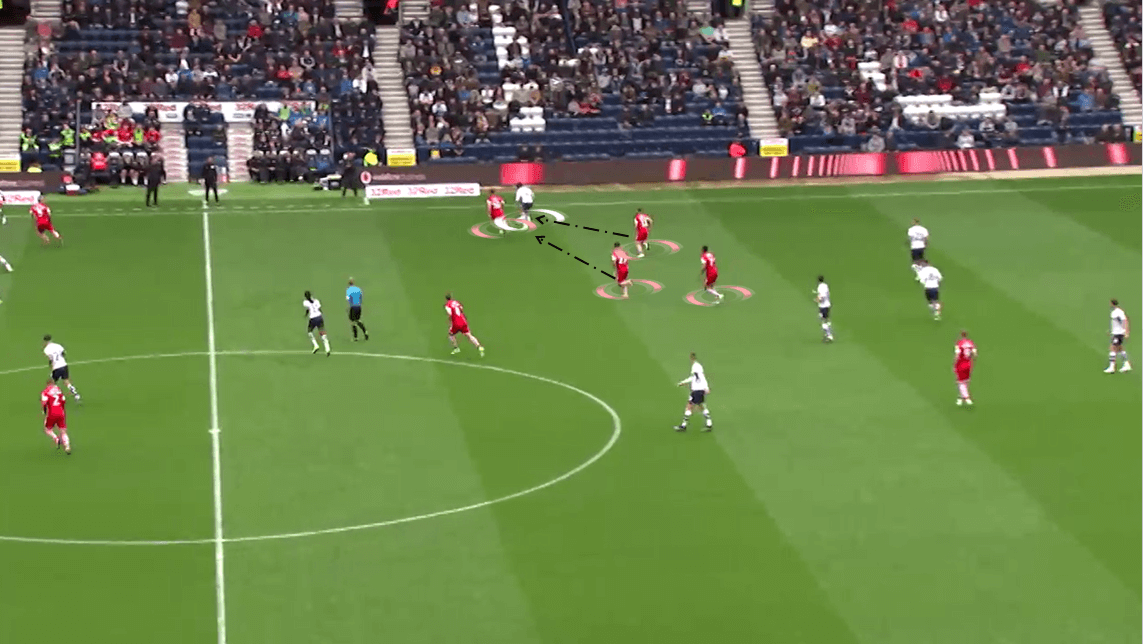
Inside the final third, Preston tend to capitalise space that the opposition’s defenders create and make passes into it. With pacey players such as Seán Maguire or Barkhuizen, it is possible for the attackers to chase after the through ball and continue the team’s attack. To make the most out of their chances, Preston players usually find themselves in a position where their shot could threaten the goalkeeper rather than letting the chances be blocked by the defenders.
They only registered an average of 2.3 blocked shots and 4 shots off target per game, the second-lowest and fourth-lowest in the league respectively. This has a big impact on Preston’s goal-scoring tally as their players are usually getting chances that have a high scoring possibility, and combined with their ability, they are able to convert chances into goals.
Another method that Preston usually use during the match is long balls. While their number of passes (406.9 passes per 90 minutes) is only considered as average among the teams, almost a quarter of them are long-ranged passes. It can be either from both centre-backs who attempt to find the attackers up front, or from the playmaker who is sending the ball into the 16-yard box.
In both of those cases, they have already identified the target they wanted to send the ball towards, which was the attackers who sat on the shoulders of defenders. As mentioned, Maguire and Barkhuizen are pacey players, and the same can be said for Johnson and Harrop. Those players usually position themselves in between the defenders and wait for a long pass to be sent towards their run, similar to the shot below. That pass will help Preston beat the opposition’s defensive line and allow the player who receives the ball to attack the space behind the line.
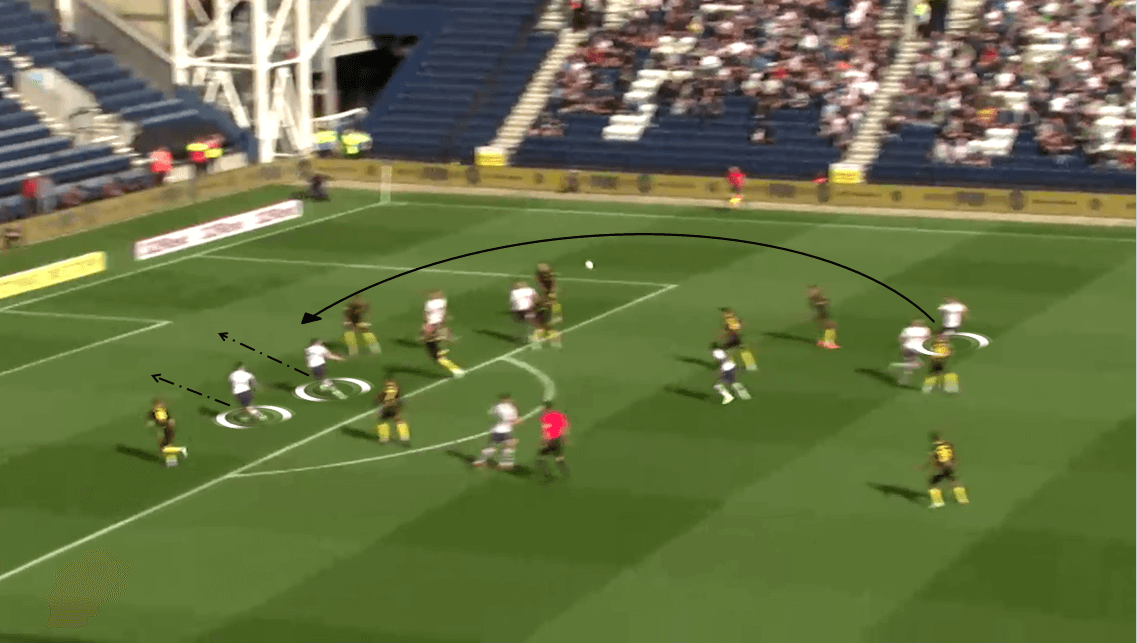
For veteran striker David Nugent though, this strategy doesn’t seem to fit his age and physicality. In the role of a target man, he usually drops deep to pick up the ball from the midfielders rather than waiting for a long pass to sprint towards the box. At the same time, his movement also drags along a couple of defenders which will create space behind their backs for both wingers to move into.
In the match against Barnsley, Preston made the most out of this plan as they knew that Halme could be struggling to keep up with pacey players. Several matches when Barkhuizen and even Jayden Stockley started up front, Neil also opted to do the same as this would help Preston to have numbers in their attack.
Defensive style of play
Being at their best at one end of the pitch, Preston also remain solid at the other end. Twelve goals conceded after eleven matches played and having the best goal difference record (+11) compared to the rest of the league aren’t bad records, but according to the numbers, they are doing worse than expected. With the xGA difference of +2.53, they are among the worst teams in terms of xGA difference. But why did the stats expected them to be one of the four teams that concede the least (9.75 xGA) and what did Preston do wrong in their defensive play?
First up, it’s worth looking at their defensive setup. Lining up in a 4-2-3-1 formation, Preston put an emphasis on stretching their shape wide to cover both central and wide areas. The defensive line usually pushes higher and position themselves near the edge of their defensive third. Meanwhile, both central midfielders have the responsibility of moving flexibly in the space between the lines to cover up every possible gap.
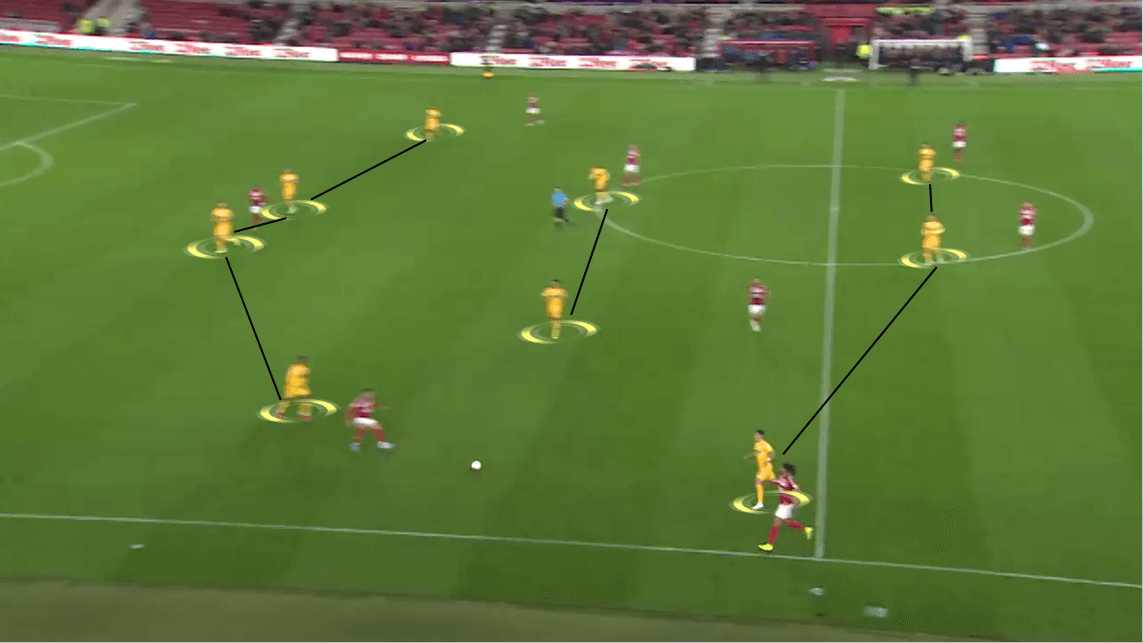
The attacking midfielder trio also remain wide with both wingers happy to occupy the half-spaces. At times, they would drop deep and create a 4-4-1-1 formation with both central midfielders. This strategy gives them an advantage that they constantly make the most out of, which is also shown in the shot above. Whenever the opposition attempt to distribute the ball wide, it is possible for the players to create an overload on either flank to win the ball back.
The nearest full-back and winger will be the first one to arrive at the area while attempting to prevent the opposition from winning numerical superiority. They will receive support by one of the central midfielders and have at least three players inside that flank to overload the area. By doing so, they put the opposition in a negative state which also allows them to apply pressure on the ball carrier, forcing them to give the ball away.
With the flexible movements in between the lines, it’s no surprise to see how high their number of interceptions is. Also, their positional awareness helps them pick out the direction of passes and clear it away from the 16-yard box. But it’s also worth noting that Preston players tend to be more aggressive in recovering possession.
Depending on the situation, the defenders can dive into tackles to win the ball back for their side. An average of almost five sliding tackles and 11.36 fouls per game are somewhat pretty high, and not to mention they register an average of one yellow card every match that they played. One of the players that really stand out when discussing discipline is Pearson. In the last two seasons for the Lilywhites, he had received an overwhelming number of 28 yellow cards and four red cards. There is an interesting fact about him that’s worth noting is that he always received exactly fourteen yellow cards in each of his recent three seasons – no more, no less.

Another name who also didn’t have such a good disciplinary record is full-back Fisher. In his first season for Preston after arriving from Rotherham, he registered an equal number of yellow cards to Pearson. But he showed signs of improvement in terms of this problem in the next season by reducing the number from fourteen to ten, though it is still a number that led to him missing two matches last season.
This has always been considered a major problem at Preston, with players getting sent off or missing from important matches which could reduce the impact that Neil wants his side to make on the match. Employing a more conservative approach in defence could be the viable option for him, but it would take time for players to get used to not diving into tackles too much. It is more important that the players, especially Pearson and Fisher, encourage themselves to stay away from sliding tackles in unnecessary situations.
The disciplinary problem is somewhat one of the factors that contribute to Preston’s problem of conceding more than expected. Still, the reason that they occasionally show during the match is the fact they leave the gaps between the defenders too wide. Similar to Preston’s mentioned method above and as displayed in the image below, the opposition’s attackers are able to position themselves inside those gaps for a through ball. Although four Preston managed to suffocate the space around the ball carrier, Jonny Howson, he still found Marcus Tavernier’s run through a lofted pass.
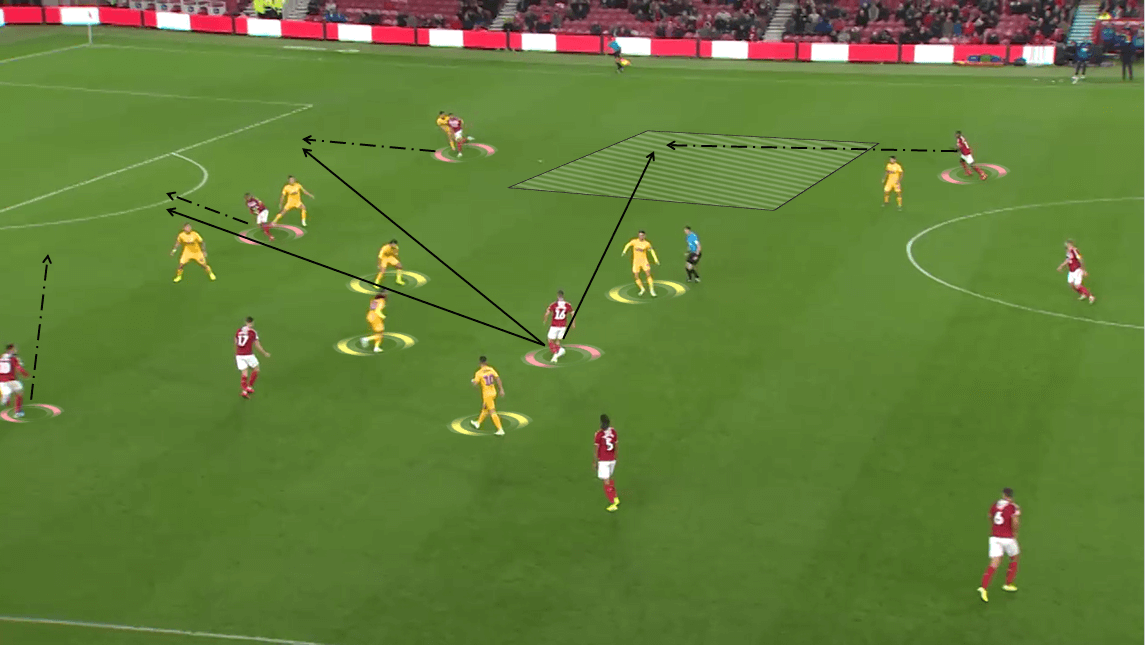
High up the pitch, Preston employ an intense pressing with a high tempo. The striker and attacking midfielder will mark the opposition’s centre-back and capitalise on heavy touches or misleading passes to start a counter-attack. As the number is the most important factor in how Neil wants his side to press, the involvement of both wingers in the press becomes crucial. They will move high up the pitch to mark either the opposition’s full-backs or centre-backs, depending on how the opposite team line up.
By doing so, it is possible for them to create a man-oriented pressing inside the opposite half and disrupt the build-up. Meanwhile, the central midfielders’ responsibilities are blocking any potential passing options and prevent through balls coming from the middle third.
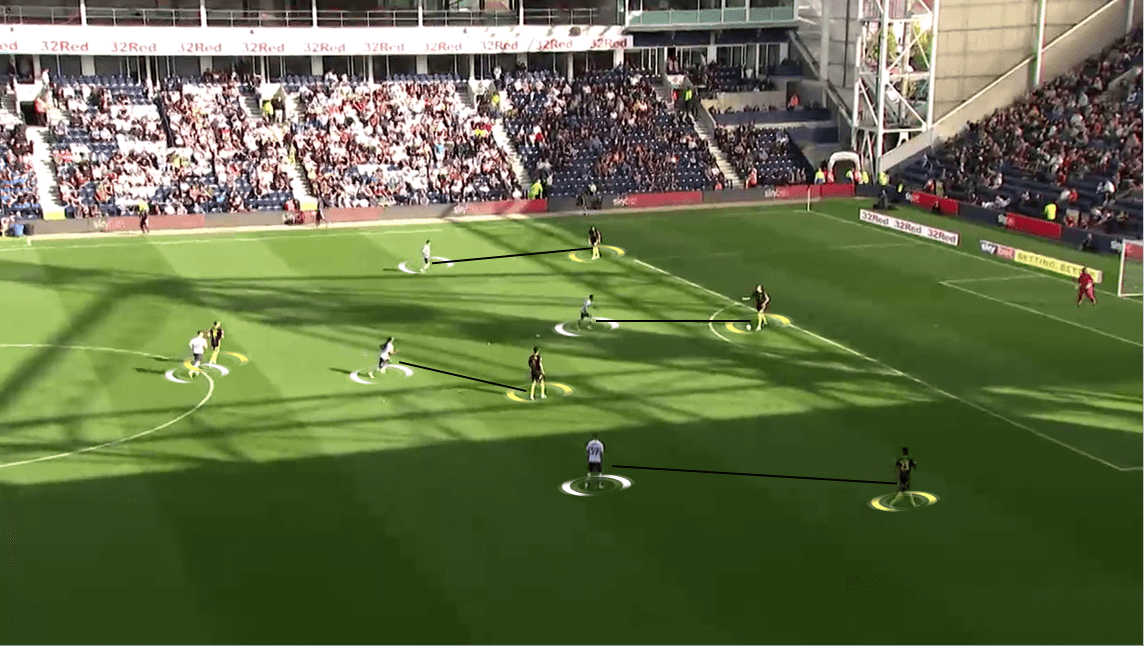
The key individuals
Being two of the players who have been playing every single match up to now, Bauer and Davies have formed a tight connection at the heart of Preston’s defence. While the latter is a key player for the team in the last two seasons, the former arrived after four seasons playing for Charlton. The German defender played an important part in the journey of returning to the Championship for Lee Bowyer’s side as he helped the club win the play-offs and finish as the second-best conceded team with forty goals.
As mentioned, both Bauer and Davies are involved quite occasionally in Preston’s build-up as they prefer to move the ball quickly into the final third. Yet they still register a respectable number of passes with 40.5 (with the accuracy rate of 73.3%) and 45.5 (78.4%) passes per game. In defence, though, they are two reliable covering defenders that usually pick out the perfect positions to clear the ball. With 5.5 and four clearances per game respectively, they are currently ranked among the top Championship defenders in this aspect, especially Bauer.
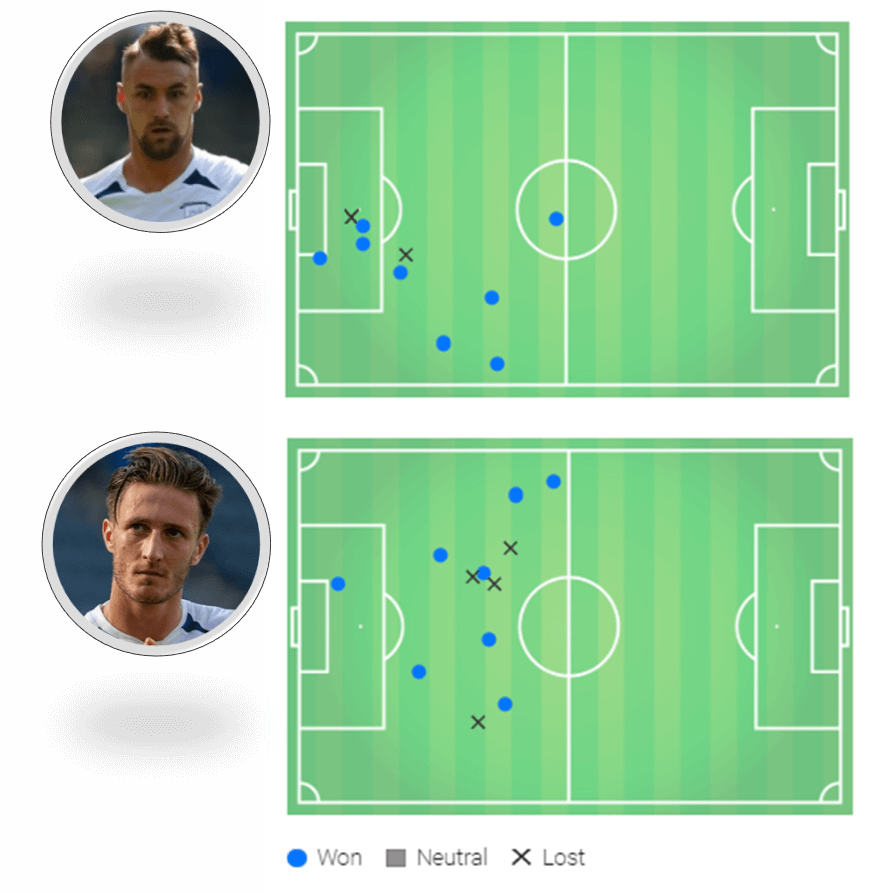
Both are still at a relatively young age (Bauer is 26 and Davies is 24) and are boasted for their energetic style of play. They aren’t shy from being involved in a defensive duel to recover possession for their team. Furthermore, being dominant in the air is also one of their strengths thanks to their physicality, which stands at 6’3” (1m 92) and 6’03”(1m 85). Above is a graphic showing the aerial duels that they made during Preston’s 1-0 win over Birmingham.
We have analysed how Preston tend to push their defensive line high up the pitch, more specifically, on the edge of the middle third. This explains why most of their aerial duels took place near the area. While they have won a significant number of it, there is a significant trend that Bauer showed: he tended to move slightly to the right-hand side to support Fisher in the air. While the former Rotherham defender is somewhat struggling to win the ball in the air, Andrew Hughes is more comfortable on the left-hand side (he won 4.3 aerial duels per match this season). This allowed Davies to roam from his position to provide support for his teammates.
In the middle area of the pitch, Pearson has been dominant in both defence and attack. The defensive midfielder provides a solid cover for the defensive line and usually does not hesitate to involve himself in a defensive duel. 2.2 tackles per game is a good number, but some might want him to improve more in intercepting the ball rather than diving into tackles. An average of 0.7 interceptions is only considered as average among the team. Still, as he constantly receives support from his colleagues Gallagher and Johnson, it will help him concentrate more on stopping the opposition’s attack and screening space in front of the defence.

Browne is somewhat of a revolution this season. Having been deployed as a dynamic midfielder in the last few seasons with Preston, he is now being tested as a right-back. Two matches played in that position wouldn’t be enough for the Irish youngster to fully develop the attributes that a full-back needs. Still, as the season has gone by, he will have more opportunities to gain more experience of playing as a full-back and this gives Neil more choices when picking the squad.
But among Preston’s midfielders, Johnson is a player who currently stands out the most. Again, he is another versatile player that Neil has on his books as he can play in almost every position in midfield. A relatively agile player, Johnson has the pace and dribbling ability to pick up the ball and drive forward. He currently sits top of the assists board with four assists to his name and second in the top-scoring board with seven goals.
As his heatmap shows, he doesn’t have a place where he spends time the most like Pearson. Instead, he would flexibly move across the pitch to link up the team’s play and position himself in an active position to receive passes, similar to a dynamic midfielder. Playing at the heart of Preston’s midfield, Johnson tends to make dribbles inside the central half of the pitch and that is also where his goals come from.
The number of shots that the Jamaican midfielder has taken is divided equally both inside and outside the box. This shows how flexible he is in positioning himself to convert the chances that he or his teammates created. The two goals that he scored against Barnsley are perfect examples, as he was in a free position to aim his shot to the direction that he wanted. Besides from being a threat in open play, Johnson is also an excellent penalty taker with four penalties completed this season.

Just below Johnson’s tally of seven goals are Barkhuizen and Maguire, who registered three and two goals respectively. We have analysed Barkhuizen’s role when he is deployed as a striker, where he usually drops from his position to link up with the midfielders. In the role of a winger, though, he combines with another Irishman in the squad in Maguire to form a prolific winger duo.
They are boasted for their pace and dribbling ability, which helps them when they tuck inside to work more inside the half-spaces and central area. With the tendency of attacking the space behind the opposition’s defensive line, both wingers usually turn up at the end of passes and sprint towards the 16-yard box.
In terms of their chances, Barkhuizen has been quite prolific inside the box, where most of his chances took place in that area and only missing one. The same can be said about Maguire but it’s worth noticing that, not most, but all of his chance were inside the box. The Irish international has converted three chances that he had inside the 6-yard box while registering a fair few numbers of shots on target from the left-hand side of the 16-yard box.
Another noticeable trait about Preston’s goal-scorers is that the players divided the total of 23 goals quite equally among the squad. They only have one player who scored more than three goals, three players who scored two goals, and four players who scored one goal. It’s fair to say that the amazing start that they have had is due to the effort every player in the team puts in their games.
Conclusion
In a season where we have seen many of the Championship teams invest heavily in their squad, Preston is one of the names who stays true to what they have known for. With no big deals and keeping the players that have been key for them over the last few seasons, the Lilywhites have built a very solid base for their ambition of reaching the Premier League.
They have a manager who has experience managing in the Premier League in Alex Neil on their touchline. Along with an attractive style of play that is only based on the simple principles and an amazing team effort, Preston are enjoying a great start after the first eleven games. It’s now up to them to maintain the position that they have worked hard to secure, and the Premier League dream returning to Deepdale won’t be far away from their reach.

If you love tactical analysis, then you’ll love the digital magazines from totalfootballanalysis.com – a guaranteed 100+ pages of pure tactical analysis covering topics from the Premier League, Serie A, La Liga, Bundesliga and many, many more. Buy your copy of the October issue for just ₤4.99 here





Comments